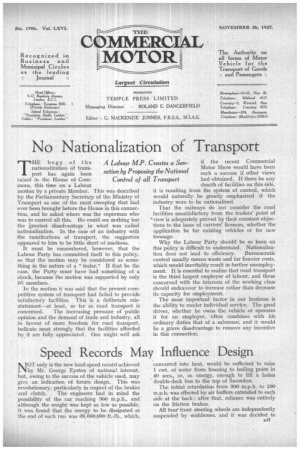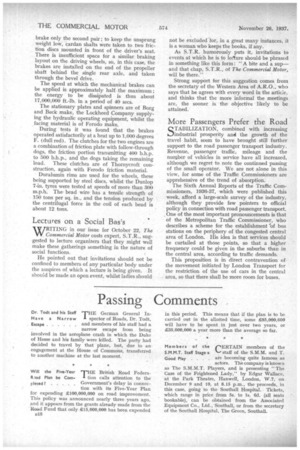Speed Records May Influence Design
Page 1

Page 2

If you've noticed an error in this article please click here to report it so we can fix it.
NOT only is the new land-speed record achieved by Mr. George Eyston of national interest, but, owing to the success of the vehicle used, may give an indication of future design. This was revolutionary, particularly in respect of the brakes arid clutch. The engineers had in mind the possibility of the car reaching 360 m.p.h., and ' although the weight was kept as low as possible, it was found that the energy to be dissipated at the end of each run was 68,000,000 ft.-lb., which, converted into heat, would be sufficient to raise 1 cwt. of water from freezing to boiling point in . 40 secs., or, as energy, enough to lift a laden double-deck bus to the top of Snowdon.
The initial retardation from 300 m.p.h. to 200 m.p.h. was effected by air buffers extended to each side at the back ; after that, reliance was entirely on the friction brakes.
All four' front steering wheels are independently suspended by wishbones, and it was decided to brake only the second pair ; to keep the unsprung . weight low, *cardan shafts were taken to two friction discs mounted in front of the driver's seat. There is insufficient space for a similar braking layout on the driving wheels, so, in this case, the brakes are installed on the end of the propeller shaft behind the single rear axle, and taken through the bevel drive.
The speed at which the mechanical brakes can be applied is approximately half the maximum ; the energy to be dissipated is thus about 17,000,000 ft.-lb. in a period of 40 secs.
The stationary plates and spinners are of Borg and Beck make, the Lockheed Company supplying the hydraulic operating equipment, whilst the facing material is of Ferodo make.
During tests it was found that the brakes operated satisfactorily at a heat up to 1,000 degrees F. (dull red). The clutches for the two engines are a combination of friction plate with follow-through dogs, the friction portion transmitting 400 b.h.p. to 500 b.h.p., and the dogs taking the remaining • load. These clutches are of Thomycroft construction, again with Ferodo friction material. Duralumin rims are used for the wheels, these being supported by steel discs, whilst the Dunlop 7-in. tyres were tested at speeds of more than 300 m.p.h. The bead wire has a tensile strength of 150 tons per sq. in.. and the tension produced by the centrifugal force in the coil of each bead is about 12 tons.






























